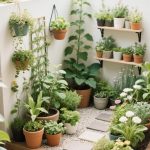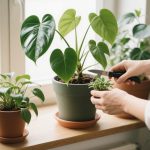Indoor plants are more than just decorative accents—they’re living air purifiers, mood boosters, and companions that thrive under your care. Whether you’re a novice plant parent or a seasoned green thumb, this comprehensive guide will equip you with science-backed strategies to nurture your leafy friends, troubleshoot common issues, and even propagate new plants like a pro.
1. Why Indoor Plants Deserve a Spot in Your Home
Decades of research confirm that houseplants do far more than elevate interior design. A 1989 NASA study revealed that plants like peace lilies and spider plants absorb volatile organic compounds (VOCs) emitted by paints, furniture, and electronics. Fast-forward to 2021, and a Journal of Environmental Psychology paper found that office workers with desk plants reported 15% higher productivity and 20% lower stress levels.
But the benefits extend beyond air quality and mental health:
- Humidity regulation: Tropical plants like Boston ferns release moisture, combating dry indoor air.
- Noise reduction: Broad-leaved species (e.g., fiddle leaf fig) absorb sound frequencies.
- Sleep enhancement: Snake plants perform CAM photosynthesis, releasing oxygen at night.
2. Choosing the Right Plants for Your Lifestyle
Not all plants suit all spaces. Consider these factors:
A. Light Conditions
- Low-light champions:
- Snake plant (Sansevieria): Survives in dim corners; water monthly.
- ZZ plant (Zamioculcas): Thrives in fluorescent office lighting.
- Pothos (Epipremnum aureum): Tolerates neglect; ideal for north-facing windows.
- Bright indirect light lovers:
- Monstera deliciosa: Requires 6–8 hours of filtered sunlight.
- Rubber plant (Ficus elastica): Develops vibrant leaves near east/west windows.
B. Pet Safety
Avoid toxic species if you have curious cats or dogs:
- Dangerous: Sago palm, lilies, philodendron.
- Pet-friendly alternatives:
- Spider plant (Chlorophytum comosum): Non-toxic and prolific.
- Parlor palm (Chamaedorea elegans): Safe for nibbling pets.
- Haworthia succulents: Spiky but harmless.
3. Mastering the Fundamentals of Indoor Plant Care
A. Watering Wisdom
Overwatering kills more houseplants than underwatering. Follow these rules:
- Check soil moisture: Insert your finger 2 inches deep. If dry, water thoroughly.
- Seasonal adjustments: Reduce watering frequency by 30% in winter.
- Pot drainage: Use containers with holes; add a layer of pebbles for extra aeration.
Pro Tip: Group plants with similar hydration needs. For example:
| Plant Type | Watering Frequency |
|---|---|
| Succulents (Aloe) | Every 3–4 weeks |
| Ferns | Weekly |
| Orchids | 5–7 days (ice cube method) |
B. Soil & Fertilizer Essentials
- Potting mix: Avoid garden soil—it compacts and harbors pests. Opt for:
- Cactus/succulent blend: 2 parts perlite, 1 part coco coir.
- African violet mix: Peat-based with added vermiculite.
- Fertilizing: Apply balanced liquid fertilizer (10-10-10 NPK) monthly during growing seasons (spring/summer).
4. Diagnosing and Fixing Common Problems
A. Yellow Leaves: The Silent SOS
- Overwatering: Soggy soil + mushy stems = root rot. Solution: Repot in dry soil; trim black roots.
- Nutrient deficiency: Yellowing between veins signals iron shortage. Apply chelated iron spray.
- Pests: Spider mites leave speckled leaves. Wipe with 1:4 rubbing alcohol/water solution.
B. Leaf Drop Drama
Sudden leaf loss often stems from:
- Temperature swings: Keep plants away from AC vents or radiators.
- Low humidity: Mist plants daily or use a $25 humidifier.
5. Level Up: Advanced Techniques for Plant Enthusiasts
A. Propagation Made Simple
Turn one plant into many:
- Stem cuttings:
- Snip a 4-inch pothos stem below a node.
- Place in water; roots emerge in 2–3 weeks.
- Leaf propagation:
- Gently twist a healthy succulent leaf.
- Let it callus for 3 days, then lay on moist soil.
B. DIY Hydroponics
Build a soil-free system:
- Materials: Mason jar, air pump, net pot, clay pebbles.
- Steps:
- Suspend the plant’s roots in nutrient-rich water.
- Use an air stone to oxygenate the solution.
- Monitor pH levels (5.5–6.5 ideal for most plants).
6. Building a Sustainable Indoor Jungle
Start small—even a single snake plant makes a difference. Track progress with apps like Planta or Blossom, which send watering reminders and diagnose issues via photo uploads. As you gain confidence, experiment with rare species like variegated monsteras or carnivorous pitcher plants.
Remember: Plants are resilient. A wilted leaf isn’t failure—it’s a lesson. With patience and these evidence-based strategies, you’ll transform your home into a thriving green sanctuary.
















